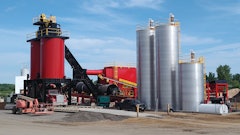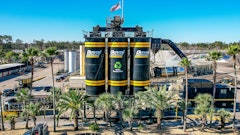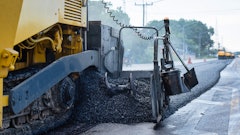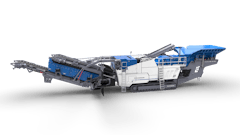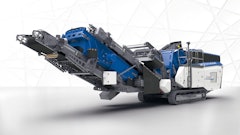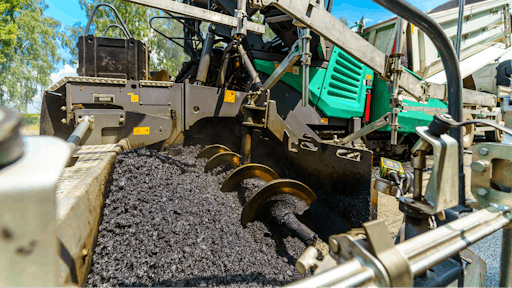
When critical equipment functions optimally, it consumes less energy. Therefore, asphalt plants can benefit from both improved energy efficiency and a lower CO2 footprint.
Asphalt mixing and installation subjects heavy equipment to a highly erosive and abrasive mixture of aggregates, binder and filler. Where aggregates used to be mainly crushed rock, sand, gravel or slags, they are now being supplemented or replaced with construction and demolition debris. The main binder used is bitumen, however more environmentally-friendly bio-based binders are also under development. Whatever its constitution, asphalt can cause intensive wear and tear that left unchecked will cause early failure. Furthermore, the deterioration of key components will lower energy efficiency and performance. It may also affect the quality of the asphalt, increasing the risk of rejection by the final customer.
Wearfacing can help address these challenges by protecting equipment against wear. In addition to extending the life of components it will help maintain their original shape and dimensions, so they continue to offer optimal performance and energy-efficiency. These treatments can be applied to asphalt processing equipment at any stage, from original manufacture or as part of a repair and restoration process. Not only does wearfacing gives components a second life, but it often results in better than new performance.
Diamond plates provide active protection against abrasion and erosion
Castodur Diamond Plates (CDP) provide the basis for comprehensive and particularly cost-effective wear protection. They feature a composite structure made by arc-welding, vacuum-fusing or laser-powder-coating of abrasion-erosion-resistant alloys onto an easily weldable steel plate. A highly controlled, high-tech production process based on advanced material science ensures premium quality and consistent properties across the entire surface.
The hardness of the CDP material is typically two or three times higher than that of the most abrasive media used in industrial processes. Its durability owes much to the presence of ultra-hard phases – with a hardness value (HV) of 1,500 to 3,000 – anchored in a robust matrix.
CDP plates can be easily cut, shaped and fitted to protect almost any surface in an asphalt production plant such as the dryer, elevator, mixing blade and casings or to construct components like the tubes for filler transport, chutes, grates and screw flights.
Tests have shown that CDP plates can offer up to five times longer service life when compared with previous solutions such as hardened steel, polyurethane and cast iron. They provide a high level of protection for equipment both while asphalt is being mixed and, just as importantly, during cleaning and maintenance. In addition, the plates are highly resistant to chipping and are available in different alloys and thicknesses, designed for specific wear scenarios. 
CDP plates are suitable for both small and large surfaces. Retrofitting them to existing equipment is straightforward, with attachment by screws, rivets or spot welding. They are simple to cut to any shape, using standard methods such as plasma arc, water jet or laser, and are also easy to join. Alternatively, Castolin Eutectic can supply CDP panels pre-cut and formed to suit a specific requirement. Precise dimensions for the plates can be measured on site by specialist engineers or taken from templates. A 3D measuring arm may be used to ensure accuracy. The engineers will return every six to nine months to check for wear and plan for possible changes at the next liner replacement. It should be noted that the robust nature of asphalt equipment means that it can change shape over its long life. Therefore, to maintain the best possible fit and function, new measurements should be taken each time.
Reinforcing route equipment
Wearfacing is not suitable only for static plant. It can be usefully applied to asphalt route equipment such as road scrapers and pavers (finishers). On road scrapers, CDP has been used very successfully to protect the rail, the rotor and the casing. On pavers, CDP is an ideal solution for lining the chain conveyor.
In one example, a chain conveyor liner manufactured from specialized heat-treated steel plate with a Brinell hardness of 400 HB was replaced by CDP. The result was a fivefold increase in component life.
Protective coatings

Whatever the maintenance or wear-related challenge in asphalt mixing plant or route equipment, Castolin Eutectic has a well-proven answer. The aim is to help customers build key components back to better than new performance over significantly extended lifetimes. A network of 700 technicians and specialists is ready to provide on-site wear detection, analysis and advice, before recommending the ideal solution. Repairs and wear protection can be applied either at the customer’s own site or in specialized workshops.









